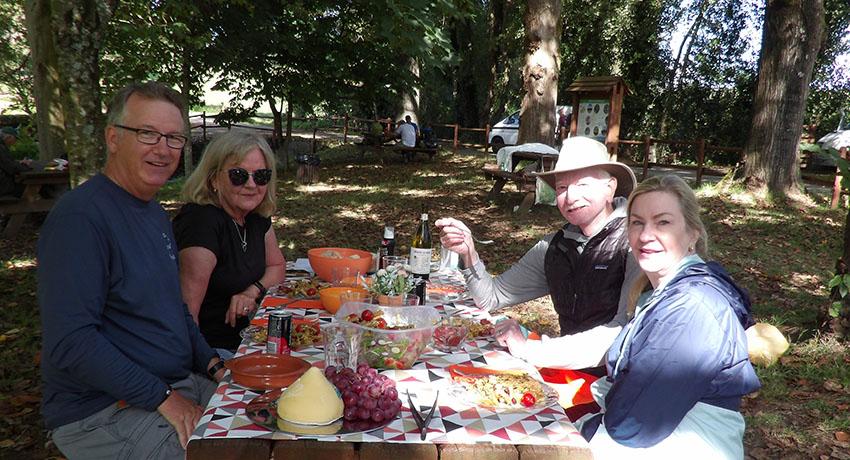A day on a Guided Tour
Updated October 2023
Picture yourself arriving in Spain on a sunny morning. Spring and Fall are fantastic times to go on a guided tour of the Camino de Santiago! You are already familiar with all you need to know to walk the Camino and you are ready to start.
Daylight lasts almost 15 hours in late spring and early fall; the sun rises early and sets late because of Galicia’s location in the northwest of Spain. If the weather is hot, you can wake up early to walk, take a nap or rest afterwards, and still be able to spend part of your day swimming in a pool or in a river or reading a book under a beautiful tree. It’s all an Iberian luxury!
Today we are going to take you on the first stage of our Classic Camino tour, one of our guided tours of the Camino de Santiago. We will be starting our camino pilgrimage from Sarria to Portomarín, a total of 22 kilometers or 14 miles.
Guided tours are an excellent way to experience the Camino because everything is taken care of for you. We book the accommodations, take your luggage from one place to the next, provide all meals, and have an English-speaking guide along that knows the history and mystery of the Camino. All you do is walk and enjoy.

If you decide to start the camino pilgrimage from Sarria, you will walk the last 111 km of the French Camino, which begins in the Pyrenees mountains 400 miles away. This is an immensely popular route because the stages are manageable, there are many cafes along the way, and it only takes 5 to 6 walking days to reach the city of Santiago de Compostela.
100 km is the minimum distance you must walk on your camino pilgrimage in order to receive the Compostela. What is the Compostela? It is a certificate you will receive in the city of Santiago at the end of your pilgrimage. There are two types of certificates, depending on your goals.
The famous Compostela is the religious or spiritual certificate which originated hundreds of years ago, written in Latin, and awarded by the Pilgrim's Office in Santiago.
There is also a certificate of distance that certifies that you have walked the Camino for your own historical and cultural interest. It is a large certificate written in Spanish on parchment paper.
In the morning, you will wake up in the village of Sarria, situated on the Oribio river, a tributary of the Miño river in the province of Lugo (Galicia). Breakfast is usually at about 8 or 8:30 in the morning. You will have a light yet filling camino breakfast to help you start the day. There is a variety of organic food available, homegrown, fresh and oh, so good!
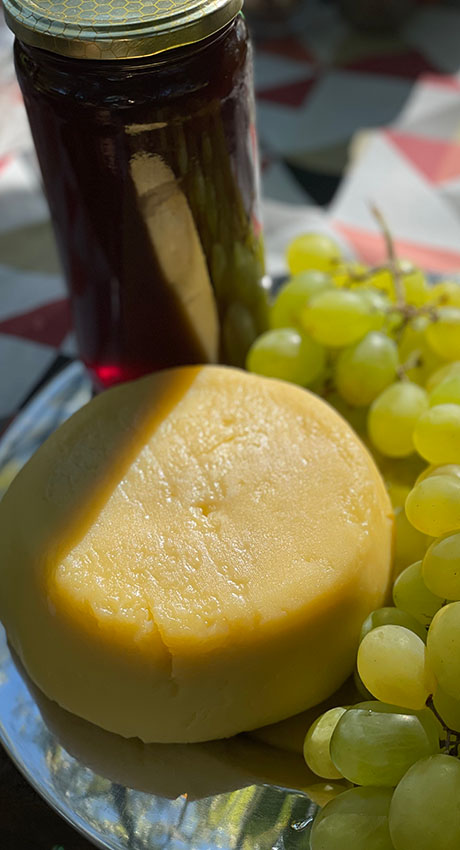
After eating breakfast and a quick bathroom stop, you will leave your suitcase in the hotel lobby with the proper label so they can be taken to your next destination, grab some water and go! The town of Sarria is somewhat hilly and you will have to walk uphill to get out of the village.
As you walk along this part of the French Camino, you will realize that most of the villages are strategically placed in valleys since Galicia is a mountainous place.
So, in the mornings we will leave the valleys, and in the afternoons when we reach our new destination, go down the slopes. You will notice a lot of ups and downs, but none of them are especially hard to manage, and a good pair of walking sticks can help.
We continue our journey through Sarria until we get to the old town where we will find the Mariña de Sarria Church. One of the unique things about this region in Spain is that they have their own language, Galician, which is remarkably like Spanish but also has some notable differences. For example, Santa Mariña in Galician is Santa Maria in Spanish (St. Mary in English). So, if you speak Spanish you might get a little confused about the language in Galicia.
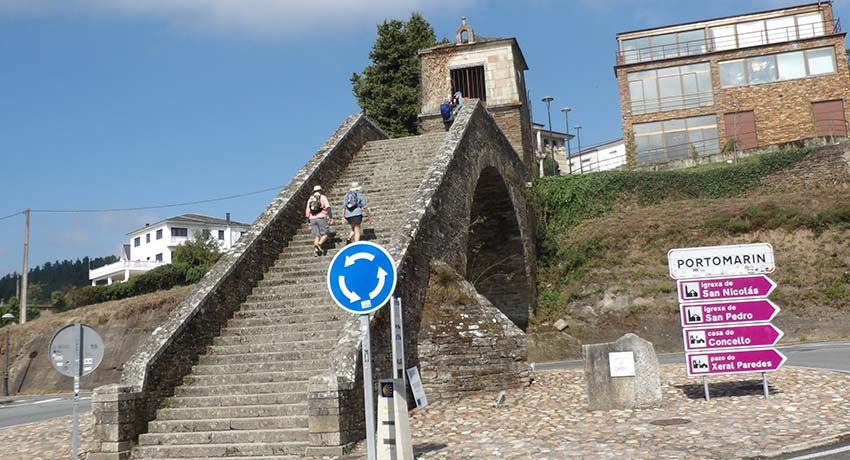
You will notice that many of the signs are both in Spanish and Galician, but when talking to locals, feel free to use Spanish since everyone will understand. By smiling, pointing, and getting others to help, you will not have any problems communicating.
If your Spanish is rusty or you don’t speak much at all, it’s reassuring to know that people in Spain are extremely friendly and helpful.
We arrive at the Church in Sarria and we stop there to put a stamp in our credential or “pilgrim’s passport”. A credential is the document that you must carry throughout your pilgrimage, and all you have to do is collect different stamps in different locations. How many stamps do you have to collect? As many as you want, although there is a minimum of 2 stamps per day.
It is very important to collect a stamp in the morning, when you start walking, when you rest and stop for lunch, and another one in the afternoon when you get to your destination so that the pilgrim office can tell that you walked between those locations on that day.
Stamps can be found in cafes, restaurants, hotels, and shops, but the best stamps are the ones from older churches. At the end of your journey you will show your credential as proof that you completed the walk and are eligible for a certificate. It is important to note that pilgrims have been denied receiving a certificate because they did not get the required 2 stamps per day and could not prove they completed the journey.
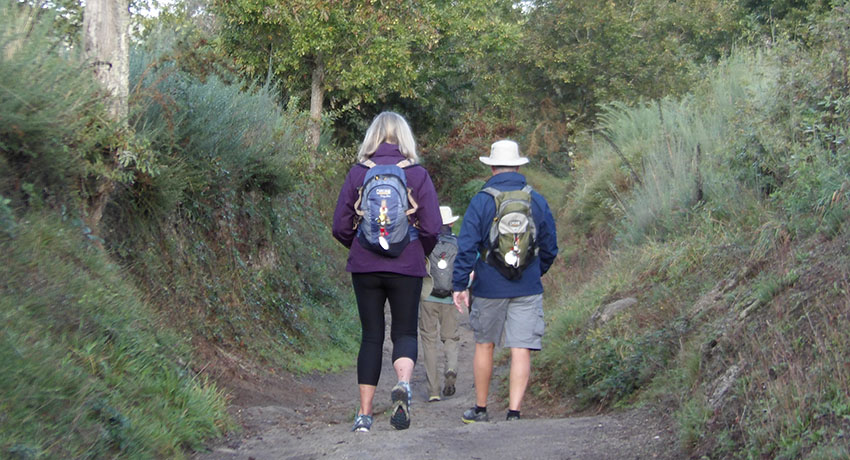
Spain has an exceptional number of monuments. On every corner there is a bit of history, therefore during your first days walking the Camino you will be impressed by how many churches and historical landmarks you will come across.
It is easy to get caught up in the beauty and history of each place you pass and, since you have the whole day to walk, you might as well visit places, take pictures and truly enjoy your time.
When you are on a guided tour of el Camino, we start off walking together, but people soon break off as they keep their own pace and tend to meet up in cafes or for a picnic lunch. And you never have to worry about getting lost. The Camino arrows are all over and markers pointing the way cannot be missed. If in doubt, the guide is always the last one in the group and will be ready to help if needed.
As we leave the city of Sarria we will find ourselves at an old cemetery, next to the convent of la Magdalena from the 12th century. Although this convent is cloistered (nuns living together, but not seen by the public) you can visit the chapel and grounds of this impressive monument if it’s open, and you can also get a stamp!
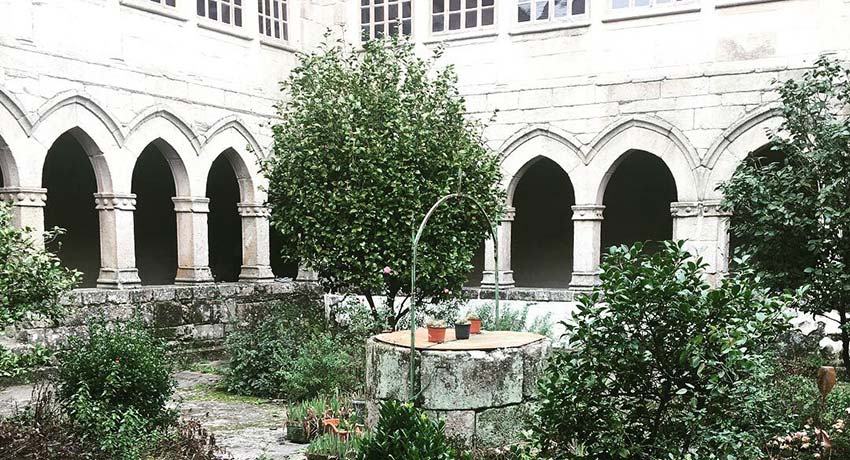
From then on you begin to descend once again to cross over a river through a stone bridge in a mountain path that snakes up and down.
You will walk through forests full of brown trees and beautiful oaks, with small critters occasionally popping out, usually in the morning.
You will eventually cross the train tracks where human and divine come together and follow on walking for about 4km until you reach your first stop on the Camino. The Aldea de Viley, with a bar, hotel, and restaurant, is one of the many places where pilgrims use to stop. Enjoy a nice cup of the famous café con leche, which is so good in Galicia, and use the restroom, because you might need it after walking for 4 kilometers.
During this stop it is important to assess the state of your feet. Are there any “hot spots” where blisters might be forming? People don’t realize it is easy to get blisters on your hands too when using walking sticks, so do a quick assessment. Change your socks, make any necessary adjustments and then you are ready to head out once again.
As you walk you’ll notice that people will pass you walking faster and you will pass people who walk slower. It is typical to greet someone as you pass them by saying “Buen Camino”.
Many times, walkers will stop and chat with you, you might see school groups of Spanish-speaking children, and you start to recognize other pilgrims that you have seen along the trail before.
It’s quite funny when “blue backpack” passes you and then later on you pass him back, as people stop at different places. All of these interactions will make your Camino memorable and unique.
You will soon find another small church on the Camino, which you can’t miss. We are talking about the church of Santiago de Barbadelo. It is a church from the 12th century which used to be an old monastery, and which is well known for its rich historical value. The pastor is a truly kind man in his 80s and he will be happy to place the church’s special stamp on your pilgrim passport.
We continue our Camino through the forests and more forests that go up and down, and when your body begins to give up and you start to get really hungry, the famous 100km sign appears. We finally reached the village of Ferreiros. In the village of Ferreiros we find a nice small area to rest and eat.
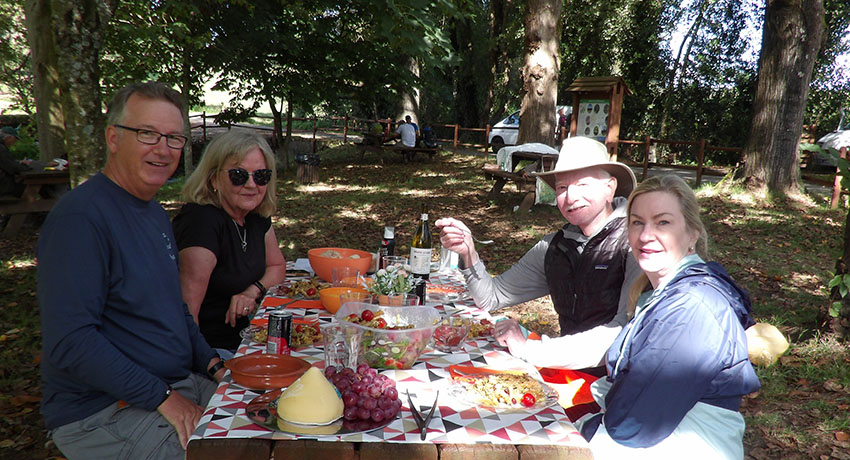
We eat our picnics between noon and 1pm. At Hike the Way, we provide gourmet picnics, and we must say that this makes other pilgrims fairly jealous when they pass by. Local cheese, salads, fruits, vegetables and of course, protein. We try our best to make sure that we don’t leave anything out and that we allow our group to try local staples of the region. And after a delicious meal, we say our goodbyes to our hosts, have another cup of coffee, and we collect another stamp before we continue walking!
It is already in the afternoon and we still need to walk another 9 km. The bad news is that it is probably hot out there by now, but the good news is that the rest of our camino guided tour is mostly downhill. After an hour sitting down to eat, most of the walkers are energized and ready to get going on their camino pilgrimage.
After crossing several small villages and traversing beautiful landscapes, we make our way downhill. We can see the river from afar and at the other side of the bridge, Portomarin. Friends, we have made it to our first destination! The village of Portomarin was founded next to a roman bridge over the Miño river in the Camino de Santiago.
The original Roman bridge and village were covered by a spectacular reservoir, built by the French in 1962.
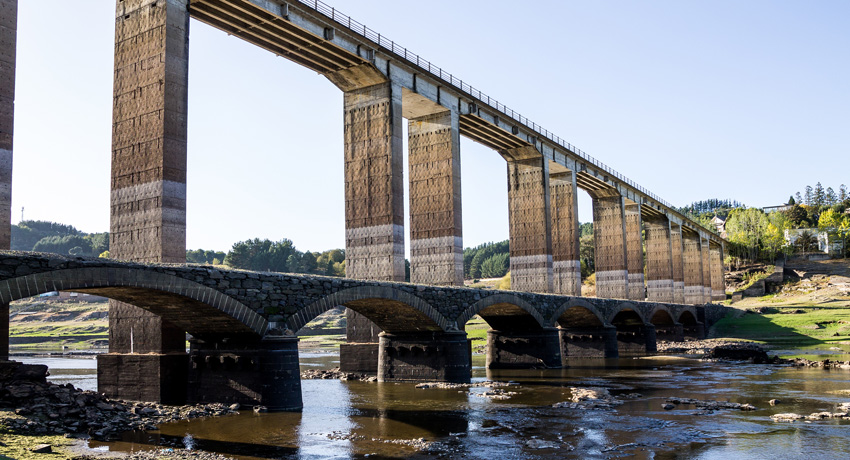
The village was moved and relocated over to the Monte de Cristo, with the Saint Nicholas church that was dismantled and built back again rock by rock. If you look closely, you can still see the numbers on each of the rocks! We cross the spectacular bridge over the reservoir, go up a few steps, and we finally get to the Saint Nicholas church and collect our last stamp!
Afterwards we check into the hotel and rest. Often times, before a nap we’ll meet again and celebrate our feat with energizing drinks, water, wine, beer or even ice cream! It’s so refreshing and all the more enjoyable because we made it past the first stage!
It’s now 3-4pm and we have the afternoon to spend however we like. Portomarin offers great views and is a fun city to explore with its winding streets and small cafes and shops. Many times, people take a nap, shower and change their clothes and shoes, and are ready to investigate what the city has to offer. It’s so nice to walk into the hotel and have our bags and rooms are all ready for us!
We all meet for dinner, tired, sore, but excited. We enjoy a sit-down locally prepared meal with lots of wine and bread, and we all talk about what to expect the next day. We will check the weather and make a plan around that in case it’s going to rain or be exceptionally hot. It’s also fun when you see some of the other pilgrims you may have chatted with along the way or passed.

At dinner you will hear people speaking many different languages, but the overall feeling is happiness and a sense of belonging. No matter where you came from or your reasons for walking the Camino de Santiago, joining a guided Camino tour will allow you to share your experience with pilgrims from all over the world.
Buen Camino, my friends!

